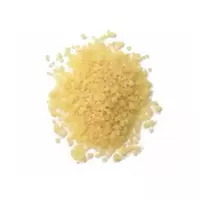Krupa kus-kus

Kus-kus is called not only the famous oriental dish (a kind of pilaf with all kinds of vegetables, fruits and spices), but also directly the cereal from which it is prepared. Kus-kus groats are made in a certain way from hard varieties of wheat, millet, barley or rice. And there are a lot of culinary recipes for preparing this dish, therefore there are many options for couscous - spicy, salty, sweet, as well as salads and snacks based on it.
From time immemorial in the East, only women were engaged in the manufacture of couscous. To do this, they sprayed small grains of semolina with water, then sprinkled them with dry grits and manually rolled up small balls. After sifting through a sieve and drying these miniature balls, the women repeated a similar process several times. And only since 1963, the production of kus-kus cereals was put into industrial production.
Interestingly, grain sizes can vary from 0. 5 to 2 mm depending on the variety. But the most popular is the kus-kus rump with a grain diameter of
1. 2 millimeters. The calorie content of couscous is quite high and amounts to about 376 kcal per hundred grams of dry raw materials.
On the menu of Algerian, Moroccan, Spanish and French restaurants, you can find a large number of dishes that are prepared based on kus-kus cereals. Delicate, crumbly golden cereal is characterized by a wonderful taste along with numerous useful properties of couscous.
Of course, in your own kitchen you can easily make some exotic dish from this cereal, which, undoubtedly, will appeal to all members of your family. By the way, in whatever capacity you use couscous, do not forget that adding honey, fruits or vegetables significantly increases the benefits of the finished dish. And the best way to preserve vitamins and valuable minerals is to prepare kus-kus cereals for steam.
Benefits of couscous
As mentioned earlier, kus-kus cereals are made from various cereals, but most often there are cereals on sale, which are made from wheat. The benefits of wheat couscous are relevant for almost all people - except for those who have food hypersensitivity or allergy to gluten. In this case, it is recommended to replace kus-kus from wheat or barley, kus-kus from rice flour.
Due to the considerable amount of vitamin V5, the benefits of couscous become obvious in neurotic disorders, depressive conditions, chronic fatigue syndrome, insomnia, as well as a general decrease in life tone. In addition, this vitamin helps to improve the regeneration of hair and skin cells, in connection with which kus-kus cereals can be called a good prevention of skin problems and early graying.
cereals kus-kus 376 kKal
Energy value of kus-kus cereals (Ratio of proteins, fats, carbohydrates - ju):
Proteins: 12.76 g (~ 51 kCal)
Fats: 0.64 g (~ 6 kCal)
Carbohydrates: 72.43 g (~ 290 kCal)
Energy ratio (b | y): 14% | 2% | 77%
 Español
Español Français
Français Português
Português Русский
Русский 简体中文
简体中文 繁體中文
繁體中文 日本語
日本語 한국어
한국어 العربية
العربية Türkçe
Türkçe Қазақ
Қазақ Deutsch
Deutsch Italiano
Italiano Українська
Українська
